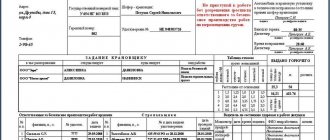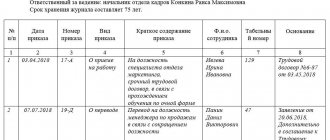Head teacher's school. Sample orders
Municipal budgetary educational institution
"Secondary School No. 1"
(High School No. 1)
Order
| 16.08.2018 | № 510 |
Ensk
On amendments to the basic educational program of secondary general education
In accordance with the Federal Law of the Russian Federation dated December 29, 2012 No. 273-FZ “On Education in the Russian Federation”, Order of the Ministry of Education and Science of Russia dated June 7, 2017 No. 506 “On Amendments to the Federal Component of State Educational Standards of Primary General, Basic General and Secondary ( complete) general education, approved by order of the Ministry of Education of the Russian Federation dated March 5, 2004 No. 1089", in order to implement the federal component of the state standard of secondary general education, based on the decision of the pedagogical council of Secondary School No. 1 dated 08/16/2018 protocol No. 9
I ORDER:
1. Make the following changes to the basic educational program of secondary general education, approved by order No. 175 dated May 13, 2017:
1.2. The content section should be stated as follows:
“Standard of secondary (complete) general education in astronomy
A basic level of
The study of astronomy at the basic level of secondary (complete) general education is aimed at achieving the following goals:
– awareness of the fundamental role of astronomy in the knowledge of the fundamental laws of nature and the formation of a modern natural scientific picture of the world;
– acquiring knowledge about the physical nature of celestial bodies and systems, the structure and evolution of the Universe, the spatial and temporal scales of the Universe, the most important astronomical discoveries that determined the development of science and technology;
– mastering the ability to explain the apparent position and movement of celestial bodies using the principles of determining location and time from astronomical objects, skills in the practical use of computer applications to determine the appearance of the starry sky at a specific point for a given time;
– development of cognitive interests, intellectual and creative abilities in the process of acquiring knowledge in astronomy using various sources of information and modern information technologies;
– use of acquired knowledge and skills to solve practical problems of everyday life;
– formation of a scientific worldview;
– developing skills in using natural science and especially physical and mathematical knowledge for an objective analysis of the structure of the surrounding world using the example of the achievements of modern astrophysics, astronomy and cosmonautics.
Mandatory minimum content of basic educational programs
Subject of astronomy
The role of astronomy in the development of civilization. The evolution of man's views on the Universe. Geocentric and heliocentric systems. Features of methods of cognition in astronomy. Practical application of astronomical research. History of the development of domestic cosmonautics. The first artificial satellite of the Earth, flight of Yu.A. Gagarin. Achievements of modern cosmonautics.
Fundamentals of practical astronomy
Celestial sphere. Special points of the celestial sphere. Celestial coordinates. Star map, constellations, use of computer applications to display the starry sky. Apparent magnitude. Daily movement of the luminaries. The relationship between the apparent location of objects in the sky and the geographic coordinates of the observer. The movement of the Earth around the Sun. Apparent movement and phases of the Moon. Solar and lunar eclipses. Time and calendar.
Laws of motion of celestial bodies
Structure and scale of the Solar system. Configuration and visibility conditions of planets. Methods for determining distances to solar system bodies and their sizes. Celestial mechanics. Kepler's laws. Determination of the masses of celestial bodies. Movement of artificial celestial bodies.
solar system
Origin of the Solar System. The Earth-Moon system. Terrestrial planets. Giant planets. Satellites and rings of planets. Small bodies of the Solar system. Asteroid danger.
Methods of astronomical research
Electromagnetic radiation, cosmic rays and gravitational waves as a source of information about the nature and properties of celestial bodies. Ground and space telescopes, the principle of their operation. Spacecraft. Spectral analysis. Doppler effect. Wien's law of displacement. Stefan-Boltzmann law.
Stars
Stars: basic physical and chemical characteristics and their mutual relationships. A variety of stellar characteristics and their patterns. Determination of distance to stars, parallax. Double and multiple stars. Extrasolar planets. The problem of the existence of life in the Universe. Internal structure and energy sources of stars. Origin of chemical elements. Variable and flare stars. Brown dwarfs. The evolution of stars, its stages and final stages.
The structure of the Sun and the solar atmosphere. Manifestations of solar activity: spots, flares, prominences. Periodicity of solar activity. The role of magnetic fields on the Sun. Solar-terrestrial connections.
Our Galaxy - Milky Way
Composition and structure of the Galaxy. Star clusters. Interstellar gas and dust. Rotation of the Galaxy. Dark matter.
Galaxies. Structure and evolution of the Universe
Discovery of other galaxies. The variety of galaxies and their main characteristics. Supermassive black holes and galactic activity. Concept of cosmology. Redshift. Hubble's law. Evolution of the Universe. Big Bang. CMB radiation. Dark energy.
Requirements for the level of training of graduates
As a result of studying astronomy at a basic level, the student should:
know/understand:
– the meaning of the concepts: geocentric and heliocentric system, apparent magnitude, constellation, oppositions and conjunctions of planets, comet, asteroid, meteor, meteorite, meteoroid, planet, satellite, star, Solar system, Galaxy, Universe, universal and standard time, extrasolar planet (exoplanet), spectral classification of stars, parallax, cosmic microwave background radiation, Big Bang, black hole;
the meaning of physical quantities: parsec, light year, astronomical unit, magnitude;
the meaning of Hubble's physical law;
– main stages of space exploration;
– hypotheses of the origin of the Solar system;
– the main characteristics and structure of the Sun, the solar atmosphere;
– the size of the Galaxy, the position and period of revolution of the Sun relative to the center of the Galaxy;
be able to:
– give examples: the role of astronomy in the development of civilization, the use of research methods in astronomy, various ranges of electromagnetic radiation to obtain information about the objects of the Universe, obtaining astronomical information using spacecraft and spectral analysis, the influence of solar activity on the Earth;
– describe and explain: differences in calendars, conditions for the occurrence of solar and lunar eclipses, phases of the Moon, daily movements of the stars, causes of ebb and flow; the principle of operation of an optical telescope, the relationship between the physical and chemical characteristics of stars using the color-luminosity diagram, the physical reasons that determine the equilibrium of stars, the source of energy of stars and the origin of chemical elements, red shift using the Doppler effect;
– characterize the features of methods of knowledge of astronomy, the main elements and properties of the planets of the Solar System, methods for determining the distances and linear dimensions of celestial bodies, possible paths of evolution of stars of various masses;
– find the main constellations of the Northern Hemisphere in the sky, including: Ursa Major, Ursa Minor, Bootes, Cygnus, Cassiopeia, Orion; the brightest stars, including: Polaris, Arcturus, Vega, Capella, Sirius, Betelgeuse;
– use computer applications to determine the position of the Sun, Moon and stars on any date and time of day for a given locality;
use acquired knowledge and skills in practical activities and everyday life to:
– understanding the relationship of astronomy with other sciences, which are based on knowledge of astronomy, separating it from pseudosciences;
– assessing information contained in media reports, the Internet, and popular science articles.”
1.3. The section “Standard of secondary (complete) general education in natural science (basic level) should be stated as follows:
a) in the third paragraph of the position “Modern natural scientific knowledge about the world” of the subsection “Mandatory minimum content of basic educational programs”, the words “Evolution of the Universe (big bang, recession of galaxies, Evolution of stars and planets, Solar system)” should be deleted;
b) in the subsection “Requirements for the level of training of graduates” (basic level):
in the “know/understand” position, exclude the words “evolution of the Universe, big bang, solar system, galaxy”;
c) in the position “to be able to”, exclude the words “scattering of galaxies”.
1.4. In subsection “2. Federal component of the state standard of general education in the context of modernization of Russian education” section “Explanatory Note”:
a) in paragraph twentieth, after the word “Physics”, add the word “Astronomy”;
b) add a new paragraph twenty-two with the following content: “Astronomy is introduced as a separate academic subject aimed at studying the achievements of modern science and technology, forming the foundations of knowledge about the methods and results of scientific research, the fundamental laws of the nature of celestial bodies and the Universe as a whole.”
1.5. The section “Curriculum” should be stated as follows:
– “On introducing changes to the federal component of state educational standards of primary general, basic general and secondary (complete) general education, approved by order of the Ministry of Education of Russia dated 03/05/2004 No. 1089” (order of the Ministry of Education of Russia dated 06/07/2017 No. 506).
Mandatory basic general education subjects are: “Literature”, “Foreign language”, “Mathematics”, “History”, “Physical education”, “Life safety”, “Astronomy” and “Natural science”.
Astronomy is introduced in 10th grade from the 2nd half of the year in the amount of 17 hours.
1.6. The section “Calendar academic schedule” should be stated as follows[1]:
Duration of training sessions by quarter in academic weeks and working days:
10th grade
| Study period | date | Duration | ||
| Start | Ending | Number of school weeks | Number of working days | |
| I quarter | 01.09.2018 | 02.11.2018 | 9 | 45 |
| II quarter | 12.11.2018 | 28.12.2018 | 7 | 35 |
| III quarter | 14.01.2019 | 22.03.2019 | 10 | 49 |
| IV quarter | 01.04.2019 | 31.05.2019 | 9 | 43 |
| Total in the academic year | 35 | 172 | ||
11th grade[2]
| Study period | date | Duration | ||
| Start | Ending | Number of school weeks | Number of working days | |
| I quarter | 01.09.2018 | 02.11.2018 | 9 | 45 |
| II quarter | 12.11.2018 | 28.12.2018 | 7 | 35 |
| III quarter | 14.01.2019 | 22.03.2019 | 10 | 49 |
| IV quarter | 01.04.2019 | 25.05.2019 | 8 | 39 |
| GIA* | 28.05.2019 | 19.06.2019 | 4 | 17 |
| Total in the academic year | 34 (excluding GIA) | 168 (excluding GIA) | ||
*The dates for conducting the State Examination of students are set by the Federal Service for Supervision in Education and Science (Rosobrnadzor).
Duration of vacations, holidays and weekends
10th grade
| Vacation period | date | Duration of vacations, holidays and weekends in calendar days | |
| Start | Ending | ||
| Autumn vacation | 03.11.2018 | 11.11.2018 | 9 |
| The winter vacation | 29.12.2018 | 13.01.2019 | 15 |
| Spring break | 23.03.2019 | 31.03.2019 | 9 |
| Summer holidays | 01.06.2019 | 31.08.2019 | 92 |
| Holidays | 4 | ||
| Weekend | 64 | ||
| Total | 193 | ||
11th grade
| Vacation period | date | Duration of vacations, holidays and weekends in calendar days | |
| Start | Ending | ||
| Autumn vacation | 03.11.2018 | 11.11.2018 | 9 |
| The winter vacation | 29.12.2018 | 13.01.2019 | 15 |
| Spring break | 23.03.2019 | 31.03.2019 | 9 |
| Summer holidays | 20.06.2019 | 31.08.2019 | 72 |
| Holidays | 4 | ||
| Weekend | 63 | ||
| Total | 172 | ||
2. I reserve control over the execution of the order.
Principal of Secondary School No. 1 _________ /L.L. Veselkina/
[1] The dates in the order are given as an example. Take into account the real dates in the academic calendar of your educational organization.
[2] The dates for state final certification in the order are given as an example. Take into account the real dates after the Ministry of Education and Science approves the schedule for passing the State Examination.
Numbering of orders for main activities
The procedure for assigning a number to an order for the main activity is not regulated by law. It is generally accepted to number POD separately from PLS and PAD, starting with each new calendar year.
Numbering not only allows you to organize an orderly AML registration system, but also makes it possible to quickly find an order by its number in the vast sea of the company’s management documentation.
Large holdings with a document flow that is significant and diverse in form and content develop their own numerological system, enshrining it in a separate local act. In this way, a unified system for numbering orders (including AML) is organized for the entire enterprise.
Such companies are typically assigned complex numbers with indices after a dividing line or hyphen, for example, No. 238/o or No. 698-u. The value of each index is deciphered in a separate instruction or local act.
How to write an order
Today there are no standards for drawing up orders approving job descriptions. So enterprises and organizations can write this document in any form or use a sample approved in the company’s accounting policies. However, some information is still required to be included:
- number,
- date and place of compilation,
- Company name,
- a complete list of job descriptions approved by the order.
The document should indicate the persons responsible for its implementation (this part concerns familiarization with the job descriptions of the company’s employees), and the job descriptions themselves, if necessary, can be noted as a separate paragraph as an appendix to the order. In addition, the order can be supplemented with any other necessary information.
Who writes the order directly
An order for approval of job descriptions can be drawn up by any employee of the organization who is assigned this function:
- legal adviser,
- HR specialist,
- secretary, etc.
The main condition is that a person has a clear idea of how to correctly draw up and execute this document.
After writing the order, it must be submitted to the director of the company for signature, since without his autograph the order will not be considered valid and subsequently it can easily be challenged in court.









